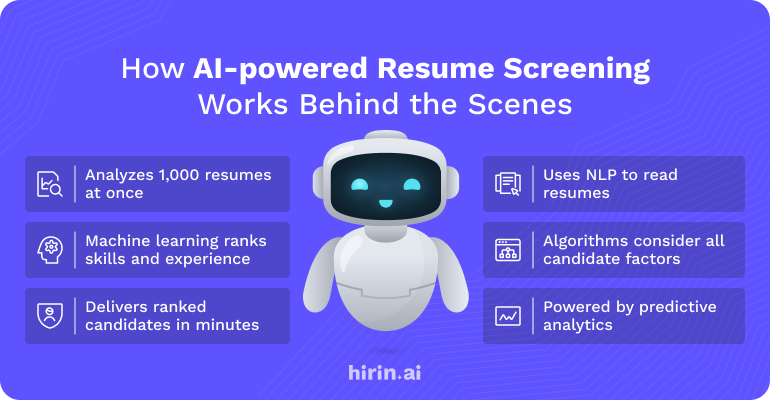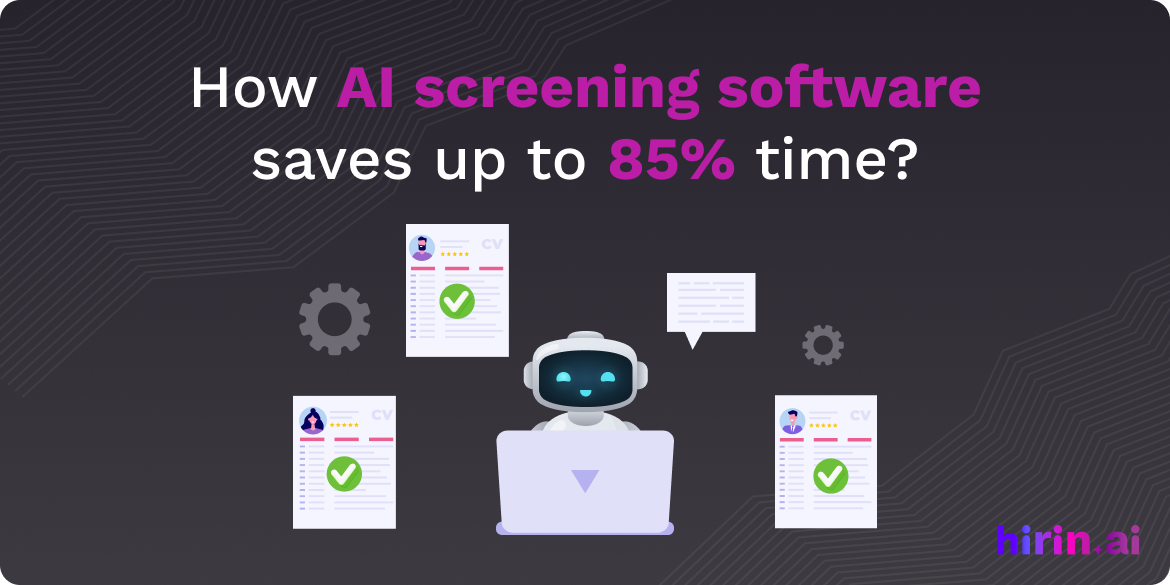Monday morning. Coffee in hand. You open your ATS and see 347 new resumes on the job post you posted last Friday!
No matter how much you scream, “How am I supposed to find one good candidate in this mess?” you will end up spending a minimum of 30-50% of your hiring time on resume and candidate screening.
Hiring professionals spend approximately 23 hours just screening candidates for a single position. That’s almost three full workdays. Gone. All on sorting through stacks of “maybe” and “nope” resumes.
Meanwhile, AI for resume and candidate screening can crush the same pile in minutes.
Manual screening isn’t just slow; it kills your hiring momentum as well.
This is exactly why 79% of recruiters, staffing agencies, and HR teams have already started using AI screening resume tools like Hirin.
Instead of manually opening one resume after another, AI software for resume screening can zip through thousands in minutes. The smart screening solution even spots top candidates you might have otherwise missed.
But how does Artificial Intelligence save you up to 85% of screening time and what goes under the hood?
Let’s explore but first understand why resume screening needs to be automated!
Why Is Resume Screening Still the Biggest Time Sink in Recruitment?
Because manual resume and candidate screening is a black hole for your time. Every scroll, endless reading, filtering by hand, and second-guess piles up. Without smart automation like AI screening resume software, you’re stuck doing slow work in a world that demands speed.
Let’s be honest. Resume screening feels endless because… well, it is.
Here’s what’s really slowing you down and why it won’t get better without help:
Resume flood
Publish one job post and you receive hundreds of resumes. But 80% won’t even meet your role’s basic requirements. Yet you still have to open each application to ensure you don’t miss the right one.
“Apply to all” madness
Thanks to job boards and easy-apply buttons, candidates throw their resumes like confetti. Not every candidate would be serious about the role. Moreover, they might not have customized or highlighted similar experiences in their profile. Not your problem… except it is.
Drawn in document scrolling
You scan for years of experience, skills, and certifications. However, one blink, and you can miss a gem. Screen meticulously every profile and your time to hire extends.
No filter. No brakes
In the absence of automated resume screening, there’s no first layer. That means every application hits your desk raw, unfiltered, and unranked.
Decision fatigue
As soon as you hit the 50th resume, they all start looking the same. Now, you don’t just miss bad fits, but chances are you miss the best ones, too.
And then we all know what would happen?
Your hiring managers or client businesses want faster shortlists. On the other side, candidates lose patience and may ghost. Most importantly, you lose hours you’ll never get back.
Manual screening used to work when job applications were received gradually. It doesn’t work when applications crash down in waves.
That’s why smart recruiters are ditching the old grind and adapting intelligent solutions.
AI pre-screening assessments and AI tools for fast candidate screening turn days of screening tasks into minutes with no compromise. Because faster screening = faster hiring.
And in this market? Obviously, speed wins.
But how can AI filter resume this fast with utmost accuracy? Let’s understand what goes under the hood when AI software is used to screen job candidates.

What Happens Behind the Scenes When AI Screens 1,000 Resumes in Minutes?
Resume screening software powered by AI like Hirin uses smart algorithms to instantly scan, sort, and score resumes based on role fit. It’s not guesswork. It’s machine learning, NLP, and recruiter-trained models working together, quietly doing what takes humans hours.
Alright, let’s pull back the curtain.
When you upload 1,000 resumes. AI does the filtering based on your pre-defined criteria. Through parallel processing, AI screening systems analyze hundreds of resumes simultaneously in minutes. So, you get a clean, ranked shortlist.
Now, you may wonder what actually happens between upload and shortlist. So, here’s what goes down under the hood:
The AI “Reads” Resumes at Lightning Speed
Using Natural Language Processing (NLP), the AI tool for candidate and resume screening understands human language. You must have experienced how Siri or Alexa understands the context regardless of what language you use, right? Similarly, AI tools screen applications based on the context of the role requirements.
NLP powers automated screening software to understand how “led a team” or “was part of the team” differ from responsibility levels. And it happens in the nick of time.
How Does AI Score Each Resume?
This is where it gets powerful. Using machine learning algorithms, AI parses and analyzes resumes to extract key information such as:
- Skills (hard + soft)
- Years of experience
- Job title alignment
- Domain/industry match
- Location preference (if needed)
And even things like project history or certification relevance. AI then compares the information with the job descriptions to measure semantic similarity. Further, AI scores each resume out of 100, and candidates are ranked based on how well their profile matches the job requirements. So instead of 1,000 resumes, you get:
- The top 10–15 most relevant candidates
- Their matching score
- Key highlights (skills, gaps, overlaps)
- Pre-screening questions, if enabled
It’s layered logic, not binary yes/no. Not to mention, AI does not take any additional time to score resumes or rank candidates.
How does AI Mimic Recruiter-like Thinking?
Recruitment automation tools like Hirin often come with an AI recruiting agent. Acting as virtual recruiters, AI recruiting agents conduct screening calls or chat via WhatsApp integration, asking basic fit questions. This is how AI recruiters not only reduce workload by automating pre-screening Q/A but also save hours per role and days per hiring cycle.
Moreover, stemming their powers from AI and its subfields like ML, NLP, Predictive Analytics, etc., these smart agents learn from hiring history. AI recruiters then apply this learning to screen and shortlist candidates like human recruiters but a thousand times faster.
So, this is how Artificial Intelligence automates screening eliminating guesswork and biases. So, no more sifting. Just decision-ready profiles. Time saved. Energy saved. Focus regained. All you need to do is let the machine do the reading. You do the hiring.
How Much Time Are You Losing Every Week Without AI Screening?
If you’re still screening manually, your staffing agency or HR department is likely losing 8–15 hours a week per recruiter. That’s nearly two full working days per recruiter gone for screening tasks that AI can easily automate. That means the higher the hiring volume, the greater the loss. Not using an AI-powered screening platform, you’re not just reading resumes. You’re also stuck in an endless loop of:
- Opening docs
- Cross-checking JDs
- Guessing relevance
- Copy-pasting into trackers
- Sending follow-up emails
Let’s do the math of the time you spend over screening without AI capabilities.
| Task | Description | Without AI (Manual) | With AI (Automated) |
| Resume Screening | Screening 100+ resumes per role to check skills, titles, and experience | 8–15 hours | 10-15 minutes |
| Initial Screening Calls | Calling 10–20 candidates to ask about availability, experience, and basic fit | 3–6 hours | 30–60 minutes (AI chat or voice) |
| Interview Scheduling | Emailing candidates to coordinate and confirm interview times across calendars | 2–4 hours | 10–20 minutes (AI auto-scheduler) |
| Candidate Q&A | Responding to repeated candidate questions about role, salary, location, or hiring process | 1–3 hours | Instant (AI chatbot) |
| Follow-ups & Re-engagement | Re-contacting candidates for status updates, reminders, or second-round screening | 1–2 hours | 10 minutes or less |
Manual total:15-20 hours/week
AI-assisted total: 1-2 hours/week
If you think your ATS alone is enough, then hear this out…
Most Applicant Tracking Systems (ATS) store resumes. They don’t screen them. They don’t learn, improve, or score fit.
And the worst part is all this manual grind slows your hiring and top candidates don’t wait. In fact, a talent trends report revealed,
80% of candidates want to be placed in less than 20 days!
As you already know, time wasted is money lost. In recruitment, speed is leverage. Which manual processes take it away, but AI provides you with that. The choice isn’t “AI or no AI.”
It’s adapting and growing with innovation or staying stuck in a rut.
Ready to Save 85% of Your Screening Time? AI for Resume Screening Make It Possible!
That’s how much time AI resume screening can save you. Per recruiter. No exaggeration. Now, imagine where you can use that saved time;
Filling roles faster
Talking to real humans
Building stronger pipelines
Finally saying “yes” to that long weekend
To be honest, manual screening is yesterday’s problem. With the advent of AI screening software, application reviewing, candidate pre-screening, and profile shortlisting have become faster and more efficient.
Choosing Hirin as your AI recruiting agent will help you screen thousands of resumes in minutes, rank top talent, and even handle pre-screening, so you don’t have to. Hirin is built for recruiters, staffing pros, and HR teams who are done wasting time and ready to win back their day.
Your first step is just a click away.
Let Hirin work. You do the winning.
